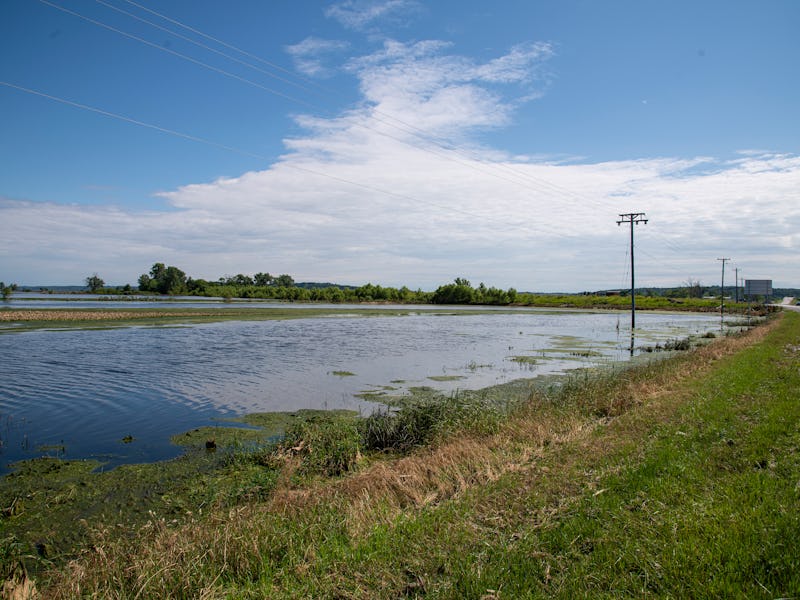‘No state in the country is spared’ from flooding risks, new report says
Scientists and policymakers can inform each others' work to better prepare communities.

The United States is getting wetter, and people across the country, from local government officials to scientists, all need to help communities prepare for an uptick in flooding, a new report says.
Flooding may conjure images of sea level rise foisting water into coastal cities, or major storms inundating them. But rising waters can cause damage anywhere, even in landlocked areas many miles from the ocean, says a report published Tuesday by the American Geophysical Union.
In response to concerns over flooding, which affect the entire United States, the nonprofit organization generated the report from scientific findings that can inform policies surrounding flood risk.
“From river flooding in rural areas of the country and port cities, to urban flooding in highly populated metropolitan and suburban areas, no state in the country is spared from the costs of flooding,” the authors of the report, entitled Surging Waters, write.
Flooding in Cedar Rapids, Iowa.
The report focuses on three types of flooding: coastal flooding, floods from hurricanes, and floods in the central United States. By telling stories of states experiencing flooding in each category, the AGU aims to give policymakers an idea of the kinds of changes they can expect from climate change, and perhaps more importantly, how to adapt accordingly.
Inland areas may seem less prone to flooding than coastal or hurricane-ravaged lands, but as climate change leads to more rainfall, rivers can overflow into surrounding communities and farmland.
Increased rainfall made the US soggier than ever this year. Through May 2019, the country saw its wettest 12-month period to date, and its second-wettest month, reports the National Oceanic and Atmospheric Administration.
The downpours caused flooding in the Midwest and South that affected 14 million people, reports The New York Times. Flood waters breached levees, rivers reached historic crest heights, and farmers had to delay planting.
In Arkansas, for example, only about half of the state’s soybean crop had been planted by early June this year. By June of 2018, Arkansas farmers had planted 90 percent of their crops.
In contrast to large-scale events like hurricanes, damage from flooding can be harder to pin down since it unfolds more slowly, The Times reports. In March of this year, for instance, heavy rain falling upon melting snow brought floods across South Dakota, Nebraska, and Iowa.
It's not just coastal cities like Miami that will flood more as a result of climate change.
The areas’ standard flood protection infrastructures couldn’t keep up with the rising waters, and by the end of June, at least 11 states were seeking federal disaster funds.
The researchers behind the AGU report hope to improve flood preparedness before flooding reaches disastrous levels. The authors also try to clear up some misconceptions, like the idea of the “100-year flood.” Such a flood doesn’t come every 100 years; rather, it has a 1% chance of occurring.
For homeowners living in a 100-year floodplain, that means there’s about a 25 percent chance of their home flooding during the span of a 30-year mortgage, the authors write.
Changing stream flows, too — the result of newly built infrastructure, changes in landscape, and climate change — can throw off flood predictions based on historical information.
While the authors say more long-term data is needed to help predict flooding more accurately, new technology is already improving the process. The National Oceanic and Atmospheric Administration developed a new flash flood prediction system which doubles the accuracy of previous estimates, zooms in on more specific areas, and runs simulations every 10 minutes. The National Weather Service began using the new system last summer to predict flash floods.
A study funded by the National Science Foundation, described in the report, found increasing flood rates between 1962 and 2011 at 34 percent of sites — which were localized in the midwestern states of North Dakota, Iowa, Missouri, Illinois, Indiana, and Ohio.
“Research confirms what communities already know: The incidence of flooding in the central United States is on the rise,” the authors write.
The AGU recommends communities and scientists forming partnerships to use science to inform policies and to conduct research that better informs communities of their flood risks. They also urge individuals to stay informed and to create emergency plans for flooding, and say that Congress can put up more funding for science-based federal agencies.
Addressing the complex challenges posed by flooding and extreme weather across the US will mean collaborating at multiple levels of society, the authors write. “Science and scientists are a key element of these solutions, but they need support from federal and local governments, and in turn they must be relevant to, accessible to, and engaged with communities.”